They may craft fine-dining menus for you at their restaurants, but the chaat on the road remains a cheap and fast favourite. Mumbai chefs pick their go-to joints...
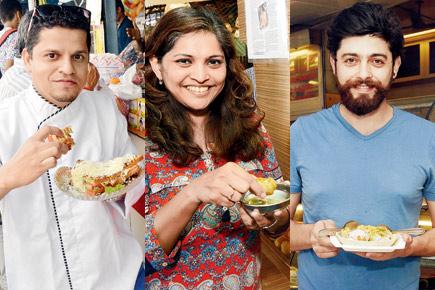
Food
ADVERTISEMENT
CHEF: Tarun Shetty from Mighty Small at Smaaash
CRAVES: Vegetable cheese grilled sandwich at Gayatri Snacks and Cold Drinks at Mithibai College, Vile Parle
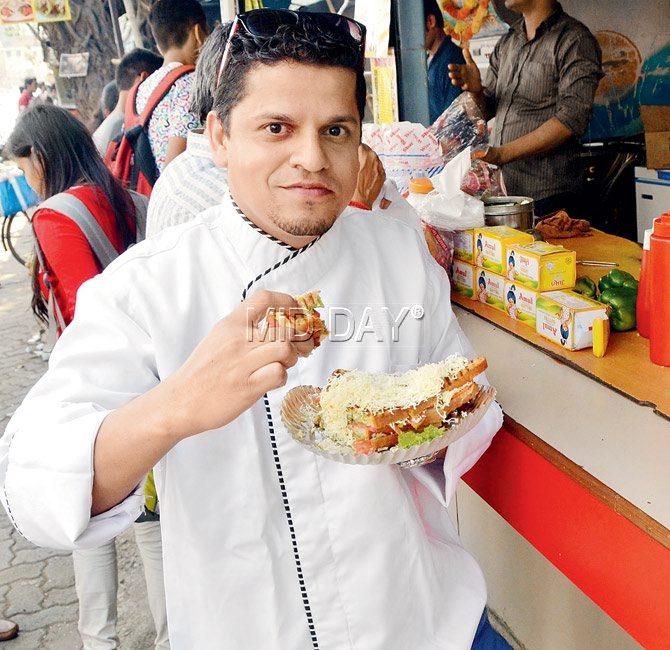
Pic/Sayyed Sameer Abedi
Chef Tarun Shetty studied at Bhavan's College, but made the long trip to Vile Parle's Mithibai College with his friends for his dose of street food. "Our favourite hangout was Gayatri Snacks and Cold Drinks for grilled sandwiches. From nearby stalls, we usually ordered mysore masala, butter onion and rava sada dosas," says Shetty. Being a South Indian, he loved home-cooked authentic appams, and idlis, but "the Bombay take was tasty too." "Be it pav bhaji, vada pav or sandwiches, people come to roadside joints to put their tongue on fire. Street food says a lot about one's city. The giant Bombay masala club sandwich at my restaurant, which is a combination of spiced potato mash, spicy green coriander chutney, cheese and veggies, is inspired from my food experience here."
CHEF: Pablo Naranjo Agular, from Le 15 Café
CRAVES: Dahi batata puri at Kailash Parbat, Colaba
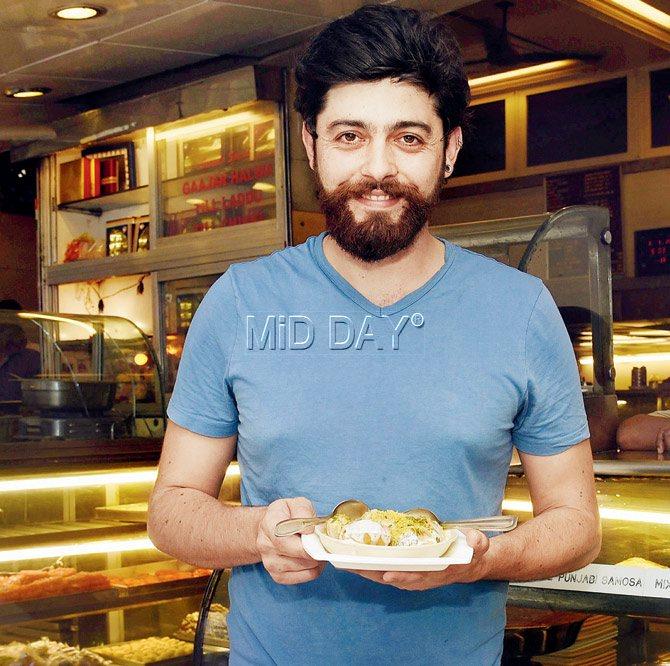 Pic/ Atul Kamble
Pic/ Atul Kamble
"Street food? What is there not to like?" asks consulting chef Pablo Augular of Le 15 Café, as he breaks a dahi batata puri he has been served with a spoon. As he wades it through the pool to collect more dahi, he adds, "Every texture is on this plate —crunch, mashed potatoes, smooth dahi and the richness of lentils. And, every flavour too — sweet-tangy tamarind sauce, the fiery taste of the red chilli powder and spice from the garam masala." His introduction to spices began thanks to a chef in Paris, who clubbed Thai and French foods. An introduction to Indian food served as higher education.
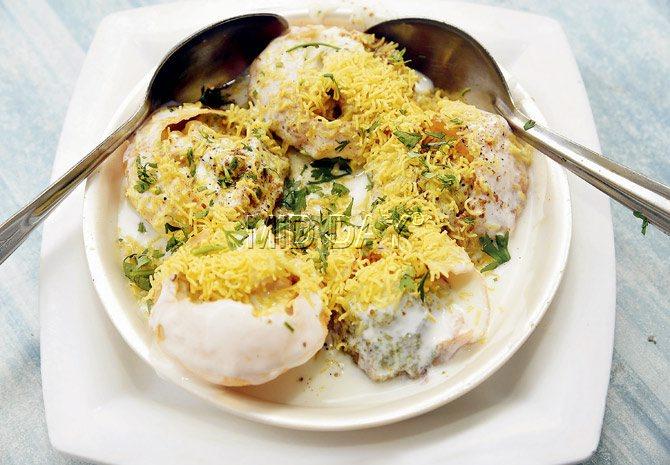 Pics/ Atul Kamble
Pics/ Atul Kamble
Augular, a Le Cordon Bleu alumni, who co-owned Plantxa, a restaurant in Paris before coming to Le 15, takes a pause to relish a big bite. Beads of sweat line his forehead. But, he will finish what's on his plate. "Street food tells you everything you need to know about a country. It is a reference to a society's gastronomy," he adds. From the dahi puri he estimates that Indians love their spice.
"They love the sweet, tangy flavour in their dishes and herbs like coriander, which is a local ingredient. Also, a large percentage of people here are vegetarian, a rarity in the rest of the world," adds Augular, who specialises in Eurpoean cusine. The 64-year-old Kailash Parbat eatery, says Augular, impresses for its fresh chutneys and balance of flavours. Back home in Colombia, he would favourite the arepas. "These are dough made of corn, boiled in milk and grinded. We top this with cheese, ham, salt and pepper. Everything I cook is linked to my childhood. My mom is Hungarian and my dad is Columbian, so I ate the best of both worlds." The arepas, he says, are not spicy. It's for this that the street food in India stands out.
CHEF: Davide Cananzi, from Yellow Bar All Day, Khar
CRAVES: Kebabs at Ayaz, Bandra
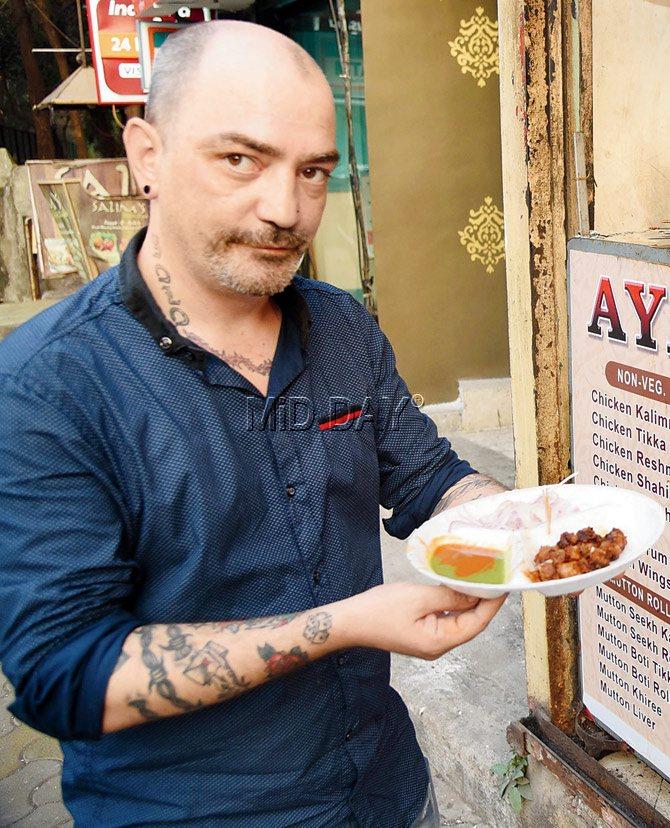 Pics/ Sameer Markande
Pics/ Sameer Markande
When he first came to Mumbai three years ago, the smell of onions and garlic on the streets took him by surprise. "Since then, I started walking around in search of different grub spots. My favourite is Masala Zone at Bandra Reclamation for its homestyle Indian food. I love to experiment with my taste buds, and am always on the lookout for flavours, textures, freshness and mixed spices. Food that is not restaurant-organised attracts me," says Davide Canazi, executive chef at Yellow Bar All Day.
On his way home to Khar from work, he frequently stops at Ayaz, for its chicken tandoori kebab. "It melts in the mouth and the charcoal tandoori taste is earthy and rustic. Hole-in-the-wall joints make you identify with where they are housed. I love how they use minimal ingredients and technique and prepare it in front of you in minutes," says Cananzi, who often craves the local foods back home, Sardinia, Italy. "The small shops serve sandwiches with meatballs, octopus, mozzarella and cold cuts. My favourite is porchetta, which is pork leg roll spiced with cumin. Mama Mia."
CHEF: Hardik Parekh, The Light House Café, Khar and Worli
CRAVES: Rajkachori, from DJ Sweets and Farsan House, Santacruz West
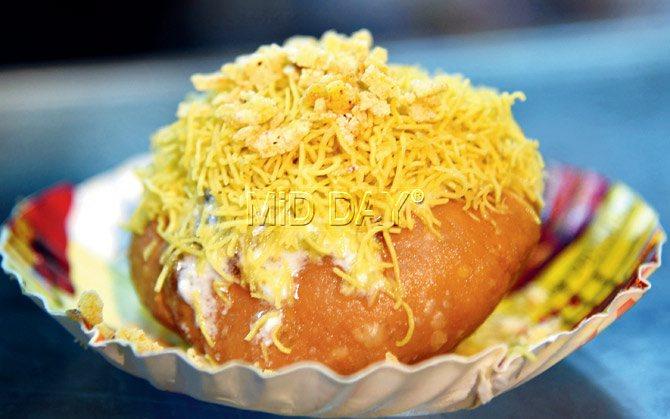
When chef Hardik Parekh aches for street food, he heads to DJ Sweets and Farsan House. The aroma from the rajkachoris welcome you from metres away. "A man sits outside the shop and fries them on a gas stove. There is theatrics in the way he plates it. He punches his thumb into the centre and pours meetha and teekha chutney, along with yogurt and chat masala," says the executive chef of Light House Cafe, Khar & Worli.
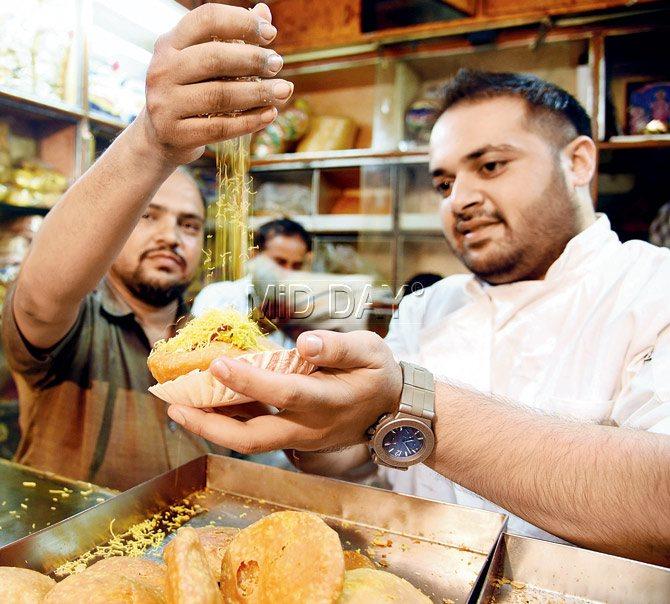 Pics/ Sameer Markande
Pics/ Sameer Markande
"Be it in India or abroad, street food is meant to pack in strong, bold flavours. People who don't eat spicy food will order bland courses at restaurants but when they want to eat pani puri or vada pav, they want to go all out. The buzz of the traffic, the clusters of people standing on the street and eating adds to the experience." The shop was established in 1910 and since then, is known for its rajkachori, among other dishes. "The food we taste in our childhood leaves a lasting impression. That's why, no other dish matches the rajkachori here," says Parekh.
On his bar food menu Parekh has included the akuri, a Parsi-styled bhurji. While it's low on oil, the flavours are big. "I want the eaters to think of an Irani café when they taste my dish. That's what makes it authentic."
CHEF: Govind Nayak, from Fable, Juhu
CRAVES: Vada Pav at Kunj Vihar, Thane
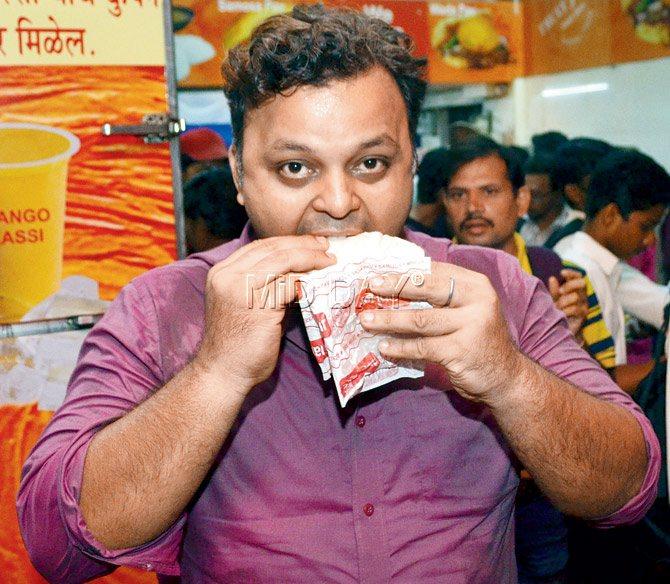
Pic/ Datta Kumbhar
"Vada pavs in the city come in all sizes. But the one near my home at Kunj Vihar, a sweet and farsan shop, it is a jumbo size, served between a fresh, soft pav. They serve it with three chutneys — a spicy green, a sweet date chutney and a dry garlic. I relish it with fried green chillies, peppered with salt," says Govind Nayak.
The vada pav is a staple for those on a budget, he says. Nayak remembers gorging on them as a student on low pocket money. "Everyone has that one special vada pav joint, and I compare the taste here to every other I try. None beat this one, thanks to the inhouse dry garlic chutney," says Nayak, adding that Kunj Vihar is also known for its fiery missal pav.
The Thane-resident's street food fetish reflects in the chat-slider which he included on the menu of his all-day eatery in Juhu. "I have created a papdi chaat with a twist — the chutneys are made from avocado, guacamole and salsa. Instead of potatoes, I use hash browns. It is topped with a poached pear chutney for sweetness."
"Street food teaches one to cook simply, yet confidently. Food of the masses has the power to tap into local taste buds and preempt the most popular demand. Food awakens the five senses, and street food adds a sixth sense to it — that of memory," Nayak signs off.
CHEF: Nicole Gonsalves Pereira, from Pico
CRAVES: Ragda chaat and pani puri at Chandru's, Seven Bungalows

For the past 18 years, chef Nicole Gonsalves Pereira, has been heading to Chandru's in Andheri West, to satiate her pani puri cravings. "And their ragda chaat is to die for," says the chef, as she digs into a puri at the 28-old eatery, that also serves Indian sweets and farsan.
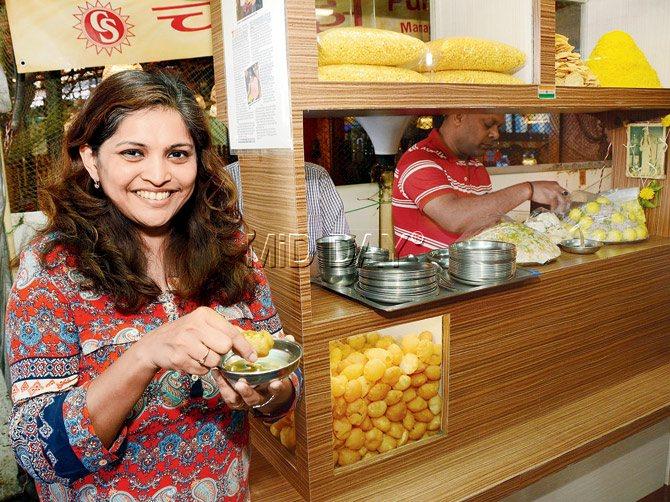
Pics/ Satej Shinde
"Their puris, made in-house, are wafer-thin, and crack in your mouth with all the pani and chutney oozing out. Since they are made in pure ghee, you know it's not as bad for you. Since I'm now on a diet, I go there once a fortnight."
"Street food soaks in the mood of the surrounding, and it is like eating in real time, as the server passes on the puri one after the other. Also, standing and eating adds to the whole experience. Even restaurants have accepted that they cannot compete with street food and have added it to their menus," says the product development chef, who has also created a date and tamarind sauce which she calls Pico Chutney. "It's convenience in a jar. I have not tampered with the recipe. It is similar to what you will find at your chaatwala and what your mum makes at home," she adds.
 Subscribe today by clicking the link and stay updated with the latest news!" Click here!
Subscribe today by clicking the link and stay updated with the latest news!" Click here!







